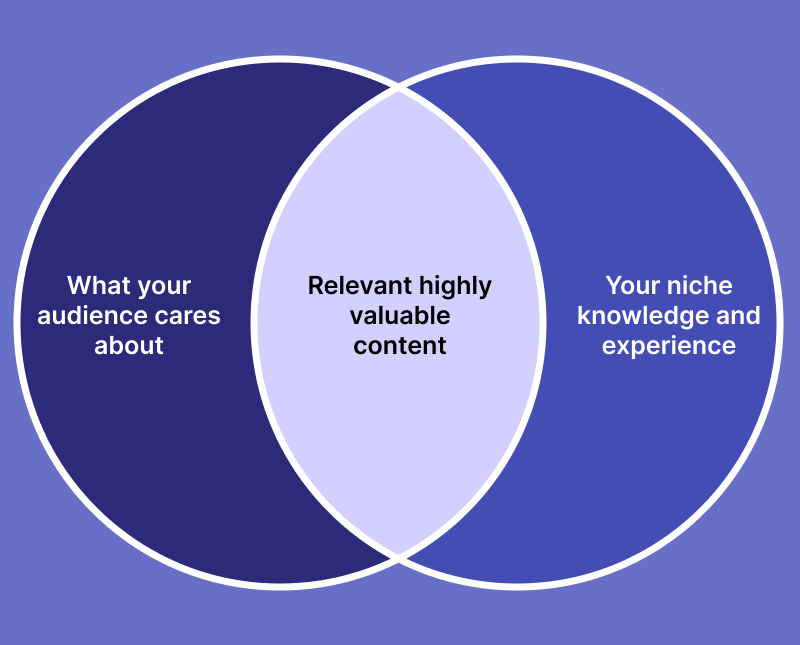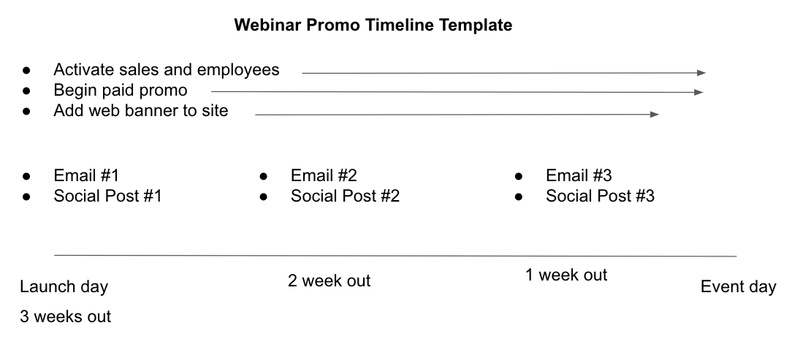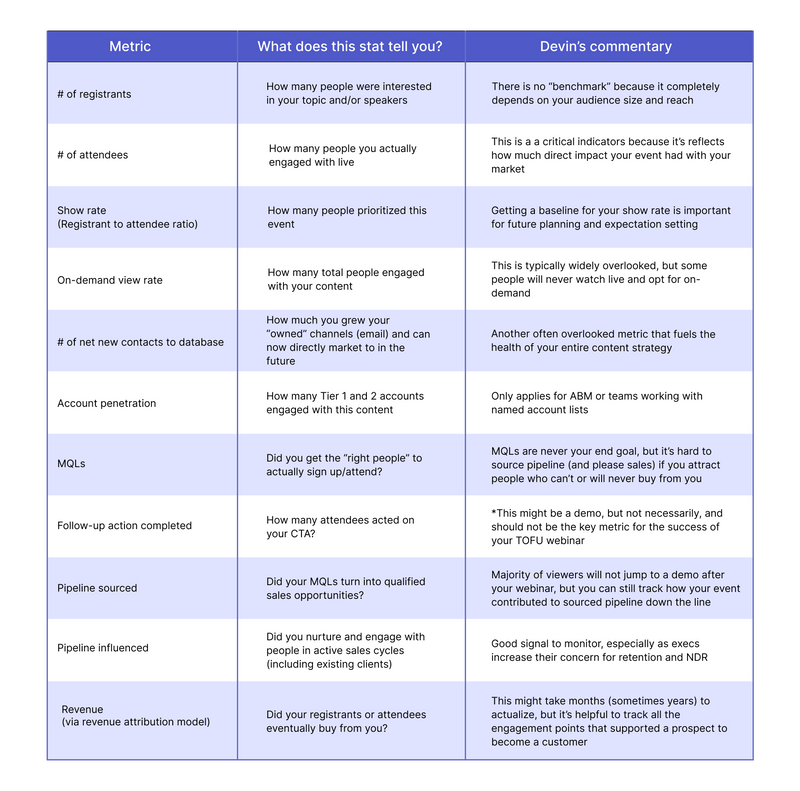How to Launch a Wildly Effective Top-Of-Funnel Webinar Series That Creates Revenue

Maximize Your Marketing ROI
Join 10,000 other marketers already getting the best tips on running engaging events that boost pipeline and create raving fans.
If you’re like me, the phrase “webinar” doesn’t spark a fountain of excitement.
That’s because most webinars are… meh.
While extremely common, most webinars have (at least) three fundamental flaws:
→ They’re a dry and boring snooze fest
→ The information isn’t very helpful
→ They’re way too long
But webinars don’t have to be low-energy
They can become a flagship part of your content strategy that brings pride to you (and your CEO) — if you have a webinar playbook that positions you and an industry expert and moves your business forward.
That’s what you’re going to learn today. Specifically:
- Definition of top-of-funnel webinars and their business impact
- The #1 mistake to avoid
- My 5-step process for designing a webinar series that your audience loves
- How to promote and follow up with sales
- How to measure success and “close the loop”
Ready? Let’s ride.
What are top-of-funnel webinars?
Top-of-funnel webinars are virtual events that provide insightful and helpful content to your audience that positions you as an industry expert.
You can focus on thought leadership, where you spark a new conversation or add a unique POV to an existing one.
Or you can provide deep expertise on an existing topic and provide frameworks that help your viewers solve a specific problem (like how to build an editorial calendar, for example).
They are incredibly impactful because they build trust at scale and fuel your pipeline.
But as you’re planning your content, there’s one thing to keep in mind…
Avoid the #1 webinar mistake
The biggest top-of-funnel webinar mistake is the ‘bait and pitch.’
That’s when instead of getting expert advice, you’re given a product pitch — either overtly or positioned as one of the 5 “tips” for solving the problem you signed up to hear about.
Remember, top-of-funnel webinars are NOT about informing people about your company or product. These events are not about selling — there’s no hard pitch.
They’re about providing value by sharing your company’s unique perspective and/or expertise on a certain topic.
“Bait and pitch” is a guaranteed way to ensure viewers never return to a future event.
Let’s talk business impact
Hosting a wow-worthy webinar that makes you and your company look good takes a fair amount of work. Here’s why that work pays dividends in the short and long term:
Top-of-funnel webinars help you achieve multiple business objectives:
- Position yourself as an industry leader
- Grow your “owned” audience
- Source qualified pipeline
- Accelerate and nurture in-pipeline deals
- Support customer renewals and source upsells
- Create new demand (if taking thought leadership approach)
In other words, they help you generate awareness trust and revenue.
And to really kick it up a notch and accelerate these benefits, swap ad-hoc, one-off events for a focused series based on a theme. This will condition your audience to expect high-quality content and keep them engaged, plus accelerate audience growth because you’re using widely-applicable topics to pull more like-minded people (i.e., would-be buyers) toward you.
The series approach is also immensely valuable for fueling your content engine because you can repurpose these digital events into 20 more pieces of content using a content waterfall framework (here’s how). This is how you get exponential value from your investment, plus grow other channels in your marketing strategy.
Five steps for creating a webinar series
Now that we’ve established the what and why, it’s time to get into the nitty-gritty of how to build one.
There are five key steps:
- Ideate
- Build
- Promote
- Follow up
- Measure
Let’s go through each one in detail.
Step 1: How to ideate compelling and relevant topics
The first step is to come up with topics that fit your series.
To do this, you need to consider two things:
1. Your audience: What topics will they be interested in?
2. Your company’s unique value proposition: What topics can you provide valuable insights on?

You want to find topics that overlap between what your audience cares about and your solution’s value props.
The goal is to balance between topics that have broad appeal and niche value but also show off your speakers’ expertise.
You can use a number of different methods to generate ideas, including:
- Ask your sales team: What topics do prospects always have questions about?
- Survey your audience: What topics would they like to learn more about?
- Scan social media: What topics are people talking about in your industry?
Once you have a list of potential topics, it’s time to narrow it down.
Start by asking:
- Who specifically do you want to register? (Think roles, seniority, industry, department, companies, etc.)
- What topics can you provide valuable insights on?
- What topics are you/your speakers passionate about?
- What topics would be fun to talk about?
(PS: If you want inspiration for naming your webinar, here’s a short guide for how to write irresistible titles.)
Once you’ve considered all of these factors and landed on a topic, it’s time to outline the actual content you’ll deliver.
Step 2: How to structure your webinar
There are three key elements to consider:
- The format: Will you do a presentation, panel discussion, or something else?
- The length: How long will the webinar be?
- The frequency: How often will you host the webinar?
Let’s break down each one.
Format
There are a few different formats you can choose from, including:
Presentation: This is the most common format. It involves one or more speakers giving a presentation on the topics you’ve chosen.
Keep in mind, this doesn’t mean you have to do “death by PowerPoint: for an hour. You can mix it up between conversation, “presenting,” and engaging with the audience to keep engagement high.
Panel discussion: This format involves a group of experts discussing the topics you’ve chosen. It’s a good option if you want to add more voices to your webinar, plus you can strategically invite speakers who are part of your ABM list or a happy customer to build relationships.
Q&A: This is a more informal format where you take questions from the audience and provide answers. It’s a good option if you want to make the webinar more interactive and foster community.
You can also shake up any of the formats above — and avoid too much “talking heads” programming — by including screen shares with breakdowns, occasional slides to highlight key takeaways, and short videos.
The only “wrong” way to do a webinar is to host something boring and dull. How you spice it up is completely up to you and in my opinion, the most fun part.
Length
The length of your webinar typically depends on the format you choose.
- Presentations are typically 45 minutes to an hour.
- Panel discussions are usually 30 minutes to an hour.
- Q&A,s run around 20 minutes to an hour.
That said, there is no “wrong” length. It’s less about how long it is and more about how valuable it is.
Pro tip: After hosting and speaking at dozens of webinars, I’ve discovered that 30 minute webinars have overall higher registration and increased attendance rates for senior leaders compared to 60 min webinars.
Frequency
The frequency of your webinar will mostly depend on where your webinar program is prioritized in your content strategy and your internal resources to support it.
If you’re just getting started and adding this on top of other channels and programs you’re running, I suggest a quarterly cadence. Once your playbook is refined and you’re ready to scale, you can mix up the formats and host one every 4-6 weeks.
Step 3: How to promote your event
Effectively promoting your event is just as important as the content itself.
Few things are more frustrating or disappointing than pouring hours of work over multiple weeks only to have 21 people register (which means like 13 people actually watched it).
If you’re going to spend the time to host a stellar event, you should go all out on the promo and include as many channels as possible. Here are a few:
- Email (prospects and customers)
- Social media
- Paid ads
- Banner on website or resource hub
- Blogs
- Podcast
- Speaker enablement
- Activate sales teams and employees to share on social
Here’s a template you can use and customize to structure your promo window:

Again, there’s no single “right” number of social posts or emails to publish. Find the balance between getting the word out and exhausting your audience.
And if you need guidance with examples, here’s how to write promos that move the needle – part 1 and part 2.
Pro tip: When promoting via email, remove recipients who’ve opened two previous emails or clicked once but never registered — these are signs they are uninterested, and continuing to pound them with the same offer will motivate them to unsubscribe.
Step 4: How to partner with Sales for post-event follow-up
It’s not enough to host a spectacular event, then move on to the next campaign. Marketing done in silos doesn’t help grow the business.
As marketers, we need to take accountability and partner with Sales to help equip them to maximize the engagement that we created.
Here’s a three-part framework I’ve developed to maximize every major marketing event.
Prepare: Give your sales team a heads up that your event is coming with a full TL;DR of all key details as soon as you can, ideally as part of your launch plan. Use multiple channels — email, Slack, all hands, etc. — to make sure they aren’t caught off guard.
This prevents confusion around ‘What the hell is marketing up to?’
Equip: You’ll drastically increase Sales’ help promoting your event if you make it dead simple. I write two copy/paste LinkedIn prompts that they can use to share with their network and email templates they can share with prospects and customers.
This overcomes, ‘Bleh this is too much work, just give me leads!’
Enable: At least a day before the event, I create an Event Pack, which is a 1-ish-page google doc on how sales can engage. It’s the “connective tissue” from event to sales follow-up.The goal is to help them go from “I didn’t see this event” to “I can confidently follow up and spark a meaningful conversation.”
(Keep in mind: attendees join to learn about a topic, not your company’s offering, so you need to prevent hard pitches in the follow up)
Here’s what’s included in the event pack:
- Event summary: title, two-sentence blurb, speakers, who this event is for and why we hosted it
- Email template for outreach
- Cold call phone script for outreach
Yes, I write the outreach for them, but I partner with sales development or sales leaders to review and finalize the templates before sharing them with their teams.
This answers, ‘How am I supposed to follow up with these leads?’
This framework creates co-ownership of your marketing campaigns that lead to collaboration and trust.
Step 5: How to measure success
The final step is to measure to understand what worked so you can celebrate (woo!) and what didn’t so you can analyze and improve.
There are a few things you should measure:

Don’t get overwhelmed here. Choose the metrics that are most important to you and your business based on your maturity stage and set baselines.
Analyzing where you’re growing or struggling will indicate where to iterate and focus for your next webinar.
Let’s wrap
Launching a high-impact webinar series has a clear and massive impact on your brand, credibility, and revenue targets.
And now you’re ready to build something BIG!
Follow this guide, and you’ll become a trusted industry leader — not just someone trying to make a quick buck. And that will pull buyers toward you (and away from your competitors).
PS: If you want more tips and guides for creating memorable content, you can subscribe to my free weekly email newsletter, The Content Strategy Reeder, here.

Stay In Touch
Platform
Resources
Company
Community
© 2025 Copyright Goldcast, Inc. All rights reserved.



 Upcoming Events
Upcoming Events Event Series
Event Series On-Demand Events
On-Demand Events

